|
I first wrote about
Goody Toys as part of my 1988-9 article on Timpo (still available on
this site here: Timpo-ModelCollector1988-9.pdf
). At that time, only three Goody Toys had come to light, and I
could find out nothing at all about the manufacturer. The models
had "Goody" TOYS MADE IN ENGLAND under the chassis, and were clearly
from the 1930s,
with their white tyres and three-part construction - a separate body,
chassis and grille, all held together by the axles like the Tootsietoy
Graham series and many 1930s Dinkies. But ignorance of Goody Toys
history prevailed for almost another 30 years. In 2007 another
body style turned up, so in fact there are four different models in the
series, then in 2016 I finally got a clue about their origin when I was
sent a scan of a 1930s catalogue from the wholesaler B.G.May of
Birmingham. In 2017 I found a Goody Toys boxed set, similar to
the catalogue pictures, and the pieces of Goody Toys history fell into
place.
Goody Toys
History
The
story starts with Jack Randall, who later had huge success with his
company J.& L.Randall Ltd., producing "Merit" plastic toys in
Potters Bar, Hertfordshire, from the 1940s to the 1970s.
According to his obituary*, Jack Randall was born in Warsaw in 1906,
and came to Britain with his widowed mother and three sisters when he
was three years old. His first job in the toy trade was in 1934,
when he became a salesman for the wholesalers Kay (Sports & Games)
Ltd. of Pembroke Works, Pembroke Road, Muswell Hill, London N10.
Incidentally, after Kay moved to 8 Carlisle Road, London NW9 in 1935,
Pembroke Works became home to the British Die Casting & Engineering
Co.Ltd., which was the firm that employed Bob Mills and Sidney Ambridge
before they started their own company, DCMT (Die Casting Machine Tools
Ltd.). It is interesting to
speculate whether British Die Casting supplied some of the toys that
were sold by Kay.The ambitious Jack Randall did not stay long at Kay, and in 1936 started Bell (Toys & Games) Ltd. with partners Lew Jones and M.Goodman. Bell traded till the 1960s at Primus House, Willow Street, London EC2, but Jack resigned from the firm in 1940, and, with his wife Lena, started J.Randall (Toys & Games) Ltd. (later J.& L.Randall Ltd.). Kay are known to toy car collectors for their boxed sets and wooden garages, and these pages from the 1937-8 Kay catalogue give some idea of the range available (click to enlarge). 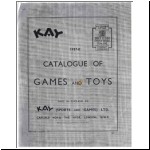  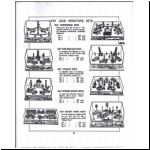 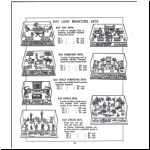 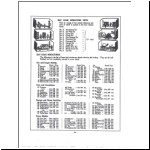 There is also a 1936-7 Kay catalogue which shows a slightly smaller range of sets, The "lead miniatures" in the sets were mostly made by Taylor & Barrett (of Finchley), and indeed the last catalogue page shown above shows that Kay were also supplying individual items, in the case of the vehicles, boxed in half-dozens. The dolls' house furniture and circus items were made by Charbens. The boxed sets were in "drop-front" packaging, with the contents sewn to a separate piece of card covering the base of the box and stapled in place. The separate box lid would hold the front of the box in place in a closed position, but with the lid removed, the front could drop down and made an instant and appealing display, with a colourful label on the inside of the box front. The whole thing was an ingenious idea and required almost no effort in display from the retailer. The photos below explain the concept much better than I can in words, and also pictured are two of the Kay wooden garages that were also in the catalogue. 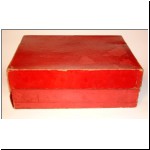 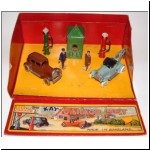 Kay Garage Set containing
Taylor & Barrett Saloon Car, Breakdown Lorry, figures and
accessories.
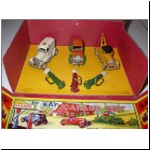 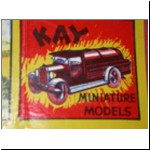 This Garage Set has
"wings" at either end of the box front. On each wing was a
picture of a petrol
tanker and the words KAY MINIATURE MODELS.
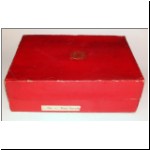 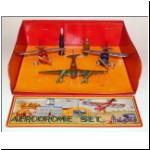 Kay Aerodrome Set containing
Taylor & Barrett aeroplanes and accessories. Note the box
label reading "No.1 Kay Aerodr[ome]". On the lid is a retailer's
label for Bragg's of Dorchester.
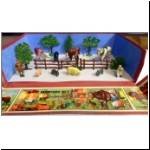 Kay Farmyard Set containing
(mostly) Taylor & Barrett farm figures, although the cart horse
looks like the Johillco horse and is probably an incorrect
addition. This is a larger box than those above - note the size
of the box relative to the label. The loose card floor is not
original.
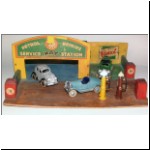  Left - Kay Service Station No.1, as
shown in the
1937-8 Kay catalogue, supplied with T&B petrol pumps and shown with
some of the other T&B vehicles that are also in the catalogue.
Right - Kay Service Station no.2,
with T&B petrol pumps and
oil cabinets. The pumps are superior to those included with
Service Station No.1, having separate hoses and filler nozzles.
The original electric lights (either side of the sign board) have been
lost. The catalogue picture shows a mirror-image version of this
service station.
We don't know how much involvement Jack Randall had with the Kay sets of T&B miniatures; certainly he would have been selling them as a sales rep. Perhaps he had more to do with the idea, or at least he recognised their sales potential, because at Bell (Toys & Games) Ltd. he introduced a very similar series of drop-front boxed sets. Bell did not use T&B models in their sets, as probably they did not want to infringe on the existing arrangement between Kay and T&B, so instead the Bell sets included Johillco vehicles and figures. Maybe this was not very satisfactory because of Johillco's slightly uninspiring range of vehicles, many of which were copies of the 1931 range of Tootsietoys and had been in production since 1932. The need for new models, more in the style of the popular Dinky Toys, is surely what lead to the creation of Goody Toys. Most likely Bell commissioned the Goody Toys range from a sub-contract diecasting firm, as an exclusive addition to their boxed sets. Possibly the name was coined by Bell's director Mr.Goodman? Reproduced below is the B.G.May catalogue page mentioned in my introductory paragraph.  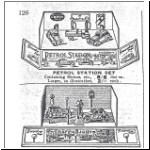 The page is annotated "Supp.[lement] to 1934 catalogue". I interpret that to mean that B.G.May produced a main catalogue in 1934, and in later years issued it with a supplement showing newer lines. The Bell sets containing Goody Toys could not be earlier than 1936, as the firm did not exist before that time, so the supplement might be from 1936 or later. The catalogue illustrates two types of Goody Toys sets, a "PETROL STATION" set and "TRAFFIC LIGHTS" set. Both boxes are shown with wings on the box fronts, carrying the "Goody Toys" name. The page also includes lead figures and other toys, not obviously by Bell. In fact the lead figures and the Armoured Car are by Crescent - the clue to this is the catalogue numbers shown in the illustrations, which are the same as in pre-war Crescent catalogues. The two sets are shown with several Goody Toys four-window cars, but curiously the Petrol Station set includes a lorry which looks like the Dinky Toy no.22c Bedford Motor Truck, and the Traffic Lights set is shown with a Tootsietoy Graham Sedan! It is just possible that Bell issued the set with the Johillco copy of the Graham, although the Johillco version should have side-mounted spare wheels that are not shown in the picture. It is tempting to think that the Johillco Grahams were also commissioned by Bell for their sets, as well as the Goody Toys, but this is speculation. It seems quite unlikely that Bell would have bought-in expensive Dinky Toys and Tootsietoys for their boxed sets, so probably the illustrations were prepared from mock-up sets that had been put together using some commercially available toys as well as the new Goody Toys. Also the Petrol Station is shown with two T&B pumps, whereas the small number of sets that we have actually seen had Johillco pumps, and it seems logical to think that Bell did not have a relationship with T&B. 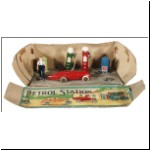  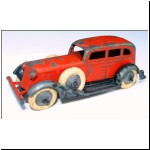
Left - Bell Petrol Station set containing the Johillco MG Record Car (called "Flying Scud" in the Johillco catalogue) and Johillco accessories. Printed bottom left on the label on the drop-front is "BELL LONDON" and bottom right is "MADE IN ENGLAND". The box lid is missing. Right - Copies of the Tootsietoy Graham
Sedan and Coupe, made by Johillco and marked MADE IN ENGLAND.
Were these also included in Bell's boxed sets?
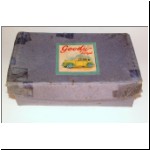 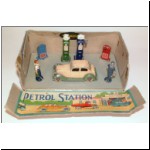 Bell
Petrol Station set containing the Goody Toys Ford Sedan and Johillco
accessories. "BELL LONDON" and "MADE IN ENGLAND"
on the drop-front. This set (and the one above) are a smaller
size than
pictured in the B.G.May catalogue, with only small wings on the box
front.
There is a "Goody Toys" label on the lid rather than on the
wings. Note the "LODGE PLUGS" label on the back wall of the box,
just as in
the catalogue picture. The loose card floor is not original.
The
"PETROL STATION" label on the above two sets pictures two cars that are
quite clearly meant to be the Goody Toys 6-window Morris and 4-window
Ford (look at the bonnet louvres in the picture and on the models),
while the "Goody Toys" label on the box lid uses the same script for
"Goody" as can be seen cast under the chassis of the models. The
Bell boxes are rather inferior in quality to the Kay versions, made of
thinner card and without the glossy paper finish, although the Bell
labels are nicely printed in bright colours.Goody Toys were probably sold by Bell during the period 1936-40, and it would be fascinating to turn up any more catalogues or adverts for the models, or indeed any more examples of the various sets. As mentioned above, Jack Randall moved on to produce Merit toys, and again he revived the idea of drop-front boxed sets, producing some which bear the Merit name. However he did not use Goody Toys in the sets, and all examples seen have contained only Johillco models. 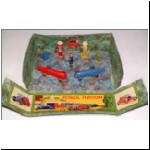 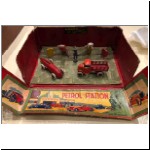 Two examples of Merit Petrol Station sets with different contents, all of which were made by Johillco. "J.RANDALL (TOYS & GAMES) LTD." and "MADE IN ENGLAND" were printed on the drop-front, together with "MERIT" in a scroll. The boxes are better quality than the Bell sets, and the artwork is delightful, showing an art deco "JR GARAGE" with an American Cord coupe at the front of the picture. These sets date from 1940-41. 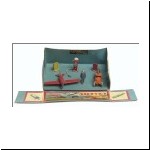 A Merit Airport set containing a Johillco monoplane, Mack truck with AA gun, and accessories. The airport set had its own illustrated label, again with beautifully executed artwork, and with "J.RANDALL (TOYS & GAMES) LTD.", "MADE IN ENGLAND" and "MERIT" printed. Goody Toys did make one more appearance, as there is a connection with Timpo Toys, mentioned in my Timpo article. In May 1941, Timpo placed a two-page advert in the trade magazine Games & Toys which shows one of their wooden garages with a Goody Toys car on the forecourt. Also in the picture are three Johillco petrol pumps! You would not necessarily assume that Timpo had produced or sold the car in the garage picture, except that a Goody Toys Ford Sedan has been found with the Goody Toys name omitted from the chassis and replaced with a blank panel. It seems likely that this was a wartime version produced for Timpo, and the same manufacturer probably cast the early post-war Timpo Pick-Up and Streamlined Saloon, which have very similar chassis (when viewed from underneath) and methods of construction. 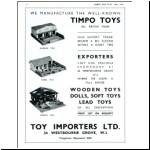 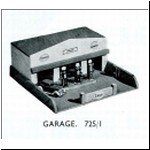 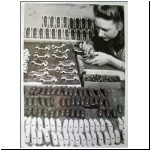 Left - May 1941 Timpo advert showing
Timpo's version of the Goody Toys Ford.
Right - A publicity photo
from late 1945 showing assembly of the Timpo Streamlined Saloon.
 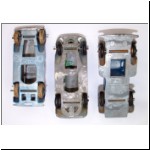 Left to right in these photos are:
- Goody Toys Ford Sedan - a version has been seen without the Goody Toys name underneath, which is probably a wartime (1941) Timpo issue. - Timpo Streamlined Saloon, produced in late 1945 (paint has been re-touched) - the design of the chassis is remarkably similar to the Goody Toys, and it was likely made by the same manufacturer. - Pick-Up Truck - the first version of this model had Timpo Toys in script underneath, similar to the Streamlined Saloon. Later models (as in the photos) had the Timpo name replaced by a blank panel, and had brass hubs instead of diecast. Probably Timpo dropped the model in favour of their simpler one-piece diecastings, and the sub-contract manufacturer then sold the un-marked version of the toy through other channels. Goody Toys
- The Models
There
are four Goody Toys, two are based on a Morris and two are Fords. They all have
the same chassis, and there are two different castings for the grilles
(Morris and Ford, obviously), which also include headlights and the
front bumper. The two Morrises both have six groups of horizontal
louvres on either side of the bonnet, while the Fords have a slightly
angled lattice design in the same position. The Morris models
are, firstly a six-light saloon with a slightly built-out boot and
spare wheel cover, and secondly a four-light coupe with a divided rear
window, again with a built-out boot and spare wheel cover. The
Fords are a two-light coupe and a four-light
Ford Tudor sedan. The Morris grille has a pattern of small
circles, which
must have been made with a punch in the die, while the Ford grille has
a more realistic pattern of thin vertical and thicker horizontal lines. 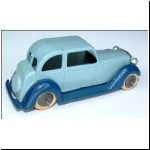 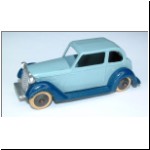 Left - Goody Toys Morris Saloon, red
body and dark brown chassis, smooth
hubs, all original apart from replacement tyres.
Right - Goody Toys Morris Coupe, smooth
hubs and thin tyres, all
original components but with restored paint.
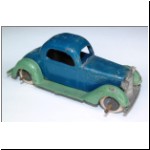 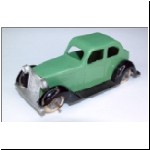 Left - Goody Toys Ford Coupe, dark blue body and green chassis, smooth hubs and thin tyres, all original.
Right - Goody Toys Ford
Tudor Sedan, green body and black chassis, smooth hubs and thin tyres, all original.
The models were zinc diecast, and were held together by thin axles. Earlier wheel hubs were smooth, with thin white rubber tyres, and the axles had a round head at one end and were crimped at the other. Later wheel hubs had a mould parting line across the diameter. Some of this type of wheel are very poorly cast. The later hubs started off with the same thin white tyres as the earlier hubs, but later had thicker white tyres, and the axles were usually crimped at both ends. Only one of my models with the later hubs has the earlier type of axles. The wheel hubs were always unpainted. The Morris Saloon had the number 0 cast underneath the roof. On the Ford Coupe and Ford Sedan the numbers 2 and 3 respectively were cast, both in mirror-image. You might expect the Morris Coupe to be numbered 1, but there was nothing cast. The Morris grille had a number 0 cast on the inside face; I have not dismantled a Ford with the original grille, so I don't know whether the Ford grille was numbered. These are die numbers, so that if faulty castings were being produced, the manufacturer could quickly identify which die was causing the problem. The models came in a wide range of colours. I have seen the following, but no doubt others exist:
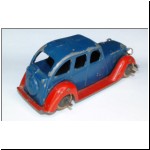 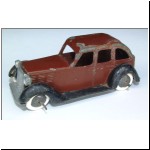 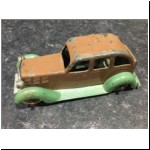 Further examples of the Goody Toys Morris
Saloon:
Left - dark blue body and red chassis, smooth hubs and thin tyres, reproduction grille. Centre - dark brown body and black chassis, later hubs, replacement tyres, some paint re-touched. Right - brown body and green chassis, smooth hubs and thin tyres.  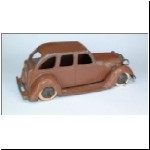 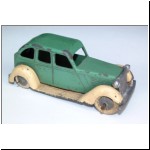
Left - brown body and red chassis, smooth hubs and thin tyres. Centre - brown body and chassis, smooth hubs and thin tyres, reproduction grille. Right - green body and cream chassis, later hubs, two thin and two thicker tyres, reproduction grille. 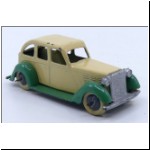 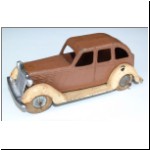 Left - cream body and green chassis, later hubs and thicker tyres. Centre - brown body and cream chassis, later hubs, thicker tyres, reproduction grille. 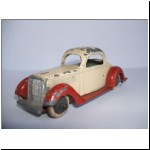 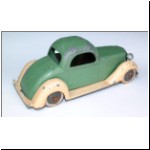 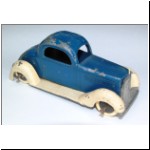 Further examples of the Goody Toys Ford
Coupe:
Left - dark blue body and cream chassis, smooth hubs, replacement tyres. Centre - green body and cream chassis, smooth hubs and thin tyres. Right - cream body and red chassis, smooth hubs and thin tyres. 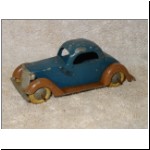 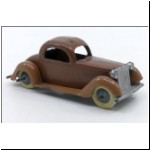
Centre - dark brown body and brown chassis, later hubs and thicker tyres. Right - dark blue body and brown chassis, later hubs and thicker tyres. 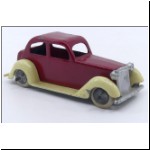 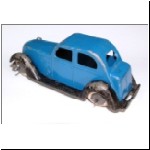 
Further examples of the Goody Toys Ford Sedan: Left - red body and cream chassis, later hubs and thin tyres. Centre - dark blue body and black chassis, later hubs and thin tyres. Right - cream body and green chassis, later hubs and thicker tyres. 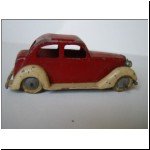 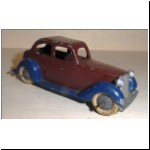 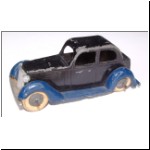 Left - red body and cream chassis, later hubs and thicker tyres. Centre - dark brown body and dark blue chassis, later hubs and thicker tyres. Right - black body and dark blue chassis, later hubs and thicker tyres. Goody Toys - Reproduction Parts 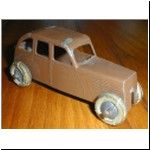 The zinc alloy used
for casting Goody Toys was of good quality, and they do not suffer from
metal fatigue, but they do have a different problem - the castings were
very thin. The chassis in particular has weak points, for example
in front of the rear mudguards, that would often get broken with play. It is not
unusual to find a Goody Toy with the chassis completely broken away,
and then of course the grille would have fallen out, because the grille
just had a lug that slid into a slot at the front of the model, and was
was not riveted in
place.
I
have found at least three Goody Toys in a similar state to the Morris
Saloon pictured here, i.e. a bodyshell with good original paint, and
the original wheels and tyres still attached, but missing the chassis
and grille. Several collectors
encountered the same problem, so some years ago Patrick Trench and
Larry Noades arranged
to produce a white metal reproduction Goody Toys chassis, to be able to
bring these broken models back to a displayable condition. The zinc alloy used
for casting Goody Toys was of good quality, and they do not suffer from
metal fatigue, but they do have a different problem - the castings were
very thin. The chassis in particular has weak points, for example
in front of the rear mudguards, that would often get broken with play. It is not
unusual to find a Goody Toy with the chassis completely broken away,
and then of course the grille would have fallen out, because the grille
just had a lug that slid into a slot at the front of the model, and was
was not riveted in
place.
I
have found at least three Goody Toys in a similar state to the Morris
Saloon pictured here, i.e. a bodyshell with good original paint, and
the original wheels and tyres still attached, but missing the chassis
and grille. Several collectors
encountered the same problem, so some years ago Patrick Trench and
Larry Noades arranged
to produce a white metal reproduction Goody Toys chassis, to be able to
bring these broken models back to a displayable condition.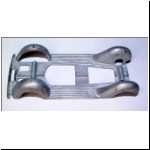 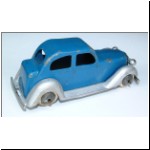 The repro chassis was
given longitudinal strengthening bars down the centre line of the
model, and this is a sure way to tell the repro from the original if
you are unsure. It is also heavier than the original.
Pictured here is a Ford Sedan with nice original blue paint,
later type hubs and thin tyres. It has been assembled with a
repro chassis and grille. The chassis still needs a coat of paint! The repro chassis was
given longitudinal strengthening bars down the centre line of the
model, and this is a sure way to tell the repro from the original if
you are unsure. It is also heavier than the original.
Pictured here is a Ford Sedan with nice original blue paint,
later type hubs and thin tyres. It has been assembled with a
repro chassis and grille. The chassis still needs a coat of paint!Patrick and Larry also arranged for a reproduction Ford grille to be made.  A reproduction Morris
grille is still available from Steve Flowers: http://model-supplies.co.uk/oddments.htm A reproduction Morris
grille is still available from Steve Flowers: http://model-supplies.co.uk/oddments.htmThe two Morris Saloons pictured here both have Steve Flowers' grilles. The model on the left has a grille from a few years ago; on the right is a more recent grille, unfortunately showing that the mould has lost a lot of definition, and the pattern of circles has almost disappeared. The model on the left also has a repro chassis. Note the slightly different shades of the original brown paint. The dark brown model (pictured further up the page, with a black chassis) is a distinctly darker colour. Goody Toys -
The Real Cars
 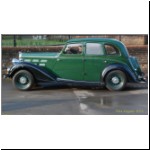  The Goody Toys cars were modelled on real vehicles from 1935, which fits with the history of the toys being developed in 1936, when Bell (Toys & Games) Ltd. was established, or soon after. The Morrises were modelled on the Morris Big Six Series II of 1935-7. The saloon was available with a 16, 18, 21 or 25hp engine, and the Morris 25 also came as a coupe. 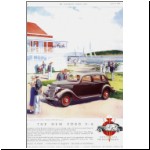 The Fords were based
on the 1935 Ford V8 Coupe and Tudor (i.e. two-door)
Sedan. The grille and bonnet louvres are distinctive and easily
identifiable to that year. These American Fords
were also built in Britain. The car is familiar
to toy collectors,
as it was modelled by Tootsietoy in several body styles (Fordor Sedan,
Coupe, Roadster and Wrecker). The Tootsietoys were one-piece
castings incorporating the mudguards and running boards into the main
body casting. This required more complicated tooling, but allowed
the toy to be produced with just one shot of the die rather than three,
and less complicated assembly. The trend to more rounded styling
with mudguards integrated into the bodywork helped the toy
manufacturers move towards one-piece castings, typified by Dinky's 39
series of American cars later in the 1930s. But Goody Toys were
not exactly in the vanguard of toy car design like Tootsietoy, and so
they adopted the standard way (for 1936) of making a toy car with a
separate chassis and grille. The Fords were based
on the 1935 Ford V8 Coupe and Tudor (i.e. two-door)
Sedan. The grille and bonnet louvres are distinctive and easily
identifiable to that year. These American Fords
were also built in Britain. The car is familiar
to toy collectors,
as it was modelled by Tootsietoy in several body styles (Fordor Sedan,
Coupe, Roadster and Wrecker). The Tootsietoys were one-piece
castings incorporating the mudguards and running boards into the main
body casting. This required more complicated tooling, but allowed
the toy to be produced with just one shot of the die rather than three,
and less complicated assembly. The trend to more rounded styling
with mudguards integrated into the bodywork helped the toy
manufacturers move towards one-piece castings, typified by Dinky's 39
series of American cars later in the 1930s. But Goody Toys were
not exactly in the vanguard of toy car design like Tootsietoy, and so
they adopted the standard way (for 1936) of making a toy car with a
separate chassis and grille.Acknowledgements Many, many thanks to Norman Joplin for scans of the B.G.May and Kay catalogues. Thanks also to Patrick Trench, whose reproduction parts have restored so many Goody Toys to collectable condition, and to several others who have contributed photos and are acknowledged in the captions. *Reference Obituary of Jack and Lena Randall in Toys International & The Retailer, August 1984. |